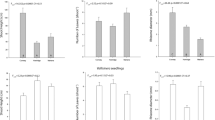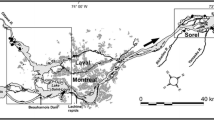Abstract
The decline of submersed aquatic vegetation (SAV) in tributaries of the Chesapeake Bay has been associated with increasing anthropogenic inputs, and restoration of the bay remains a major goal of the present multi-state “Bay Cleanup” effort. In order to determine SAV response to water quality, we quantified the water column parameters associated with success of transplants and natural regrowth over a three-year period along an estuarine gradient in the Choptank River, a major tributary on the eastern shore of Chesapeake Bay. The improvement in water quality due to low precipitation and low nonpoint source loadings during 1985–1988 provided a natural experiment in which SAV was able to persist upstream where it had not been for almost a decade. Mean water quality parameters were examined during the growing season (May–October) at 14 sites spanning the estuarine gradient and arrayed to show correspondence with the occurrence of SAV. Regrowth of SAV in the Choptank is associated with mean dissolved inorganic nitrogen <10 μM; mean dissolved phosphate <0.35 μM; mean suspended sediment <20 mg l−1; mean chlorophylla in the water column <15 μg l−1; and mean light attenuation coefficient (Kd) <2 m−1. These values correspond well with those derived in other parts of the Chesapeake, particularly in the lower bay, and may provide managers with values that can be used as target concentrations for nutrient reduction strategies where SAV is an issue.
Similar content being viewed by others
Literature Cited
Antia, N. J., B. R. Berland, D. J. Bonin, andS. Y. Maestrini. 1975. Comparative evaluation of certain organic and inorganic sources of nitrogen for phototrophic growth of marine microalgae.Journal of the Marine Biological Association of the U.K. 55:519–539.
Banse, K., C.P. Falls, andL.A. Hobson. 1963. A gravimetric method for determining suspended matter in sea water using Millipore filters.Deep-Sea Research 10:693–642.
Barko, J. W. andR. M. Smart. 1981. Sediment-based nutrition of submersed macrophytes.Aquatic Botany 10:339–352.
Carter, V. andN. Rybicki. 1986. Resurgence of submersed aquatic macrophytes in the tidal Potomac River, Maryland, Virginia, and the District of Columbia.Estuaries 9:368–375.
Champ, M. A., G. A. Gould, W. E. Bozzo, S. G. Ackelson, andK. C. Vierra. 1980. Characterization of light extinction and attenuation in Chesapeake Bay, August 1977, p. 263–277.In V. S. Kennedy (ed.), Estuarine Perspectives. Academic, New York.
Connor, J. L. 1979. Benthic Macroalgae Associated with Central Chesapeake Bay Oyster Communities. M.S. Thesis, University of Maryland, College Park, Maryland. 126 p.
Cronin, W. B. andD. W. Pritchard. 1975. Additional statistics on the dimensions of the Chesapeake Bay and its tributaries: Cross-section widths and segment volumes per meter depth. Johns Hopkins University, Baltimore, Maryland. 475 p.
Dennison, W. C., R. J. Orth, K. A. Moore, J. C. Stevenson, V. Carter, S. Kollar, P. W. Bergstrom, andR. Batiuk. 1993. Assessing water quality with submersed aquatic vegetation.Bioscience 43:86–94.
Fisher, T. R., L. W. Harding, D. W. Stanley, andL. G. Ward. 1988. Phytoplankton, nutrients, and turbidity in the Chesapeake, Delaware, and Hudson estuaries.Estuarine, Coastal and Shelf Science 27:61–83.
Gerloff, G. C. andP. H. Krumbholz. 1966. Tissue analysis as a measure of nutrient availability for the growth of angiosperm aquatic plants.Limnology and Oceanography 11:529–537.
Goldsborough, W. J. andW. M. Kemp. 1988. Light responses of a submersed macrophyte: Implications for survival in turbid waters.Ecology 69:1775–1786.
Jagels, R. andA. Barnabas. 1989. Variation of leaf ultrastructure ofRuppia maritima L. along a salinity gradient.Aquatic Botany 33:207–221.
Kemp, W. M., W. R. Boynton, J. C. Stevenson, R. R. Twilley, andJ. C. Means. 1983. The decline of submerged vascular plants in the upper Chesapeake Bay: Summary of results concerning possible causes.Marine Technology Society Journal 17: 78–89.
Kemp, W. M., W. R. Boynton, R. R. Twilley, J. C. Stevenson, andL. G. Ward. 1984. Influences of submersed vascular plants on ecological processes in upper Chesapeake Bay, p. 367–394.In V. S. Kennedy (ed.), The Estuary as a Filter. Academic Press, New York.
Kirk, J. T. O. 1983. Light and Photosynthesis in Aquatic Ecosystems. Cambridge University Press, Cambridge, United Kingdom. 401 p.
Koifoid, C. A. 1903. The plankton of the Illinois River, 1894–1899, with introductory notes on the hydrography of the Illinois River and its Basin. Part 1, Quantitative investigations and general results. Bulletin of the Illinois Laboratory of Natural History. 629 p.
Lee, V. andS. Olsen. 1985. Eutrophication and management initiatives for the control of nutrient inputs to Rhode Island coastal lagoons.Estuaries 8:191–202.
Lipschultz, F., J. J. Cunningham, andJ. C. Stevenson. 1979. Nitrogen fixation associated with four species of submersed angiosperms in the central Chesapeake Bay,Estuarine, Coastal and Shelf Science 9:813–818.
Lomax, K. andJ. C. Stevenson. 1982. Diffuse source loadings in a flat coastal plain watershed: Water movements and nutrient budgets. Maryland Department of Natural Resources, Annapolis, Maryland, 72 p.
Lubbers, L., W. R. Boynton, andW. M. Kemp. 1990. Variations in structure of estuarine fish communities in relation to abundance of submersed vascular plants.Marine Ecology-Progress Series 65:1–14.
Malone, T. C., L. H. Crocker, S. E. Pike, andB. W. Wendler. 1988. Influence of river flow on the dynamics of phytoplankton production in a partially stratified estuary.Marine Ecology-Progress Series 48:235–249.
Morris, I. 1972. Nitrogen assimilation and protein synthesis, p. 583–635.In I. Morris (ed.), Algal Physiology and Biochemistry. University of California Press, Berkeley, California.
Orth, R. J., A. A. Frisch, J. F. Nowak, andK. A. Moore. 1987. Distribution of submerged aquatic vegetation in the Chesapeake Bay. Virginia Institute of Marine Science, College of William and Mary, Gloucester Point, Virginia. 247 p.
Orth, R. J. andA. A. Moore. 1983. Chesapeake Bay: An unprecedented decline in submerged aquatic vegetation.Science 222:51–53.
Orth, R. J. andK. A. Moore. 1984. Distribution and abundance of submerged aquatic vegetation in Chesapeake Bay: An historical perspective.Estuaries 7:531–540.
Orth, R. J. andK. A. Moore. 1988. Submerged, aquatic vegetation in the bay: A barometer of bay health, p. 619–629.In M. Lynch (ed.), Understanding the Estuary: Advances in Chesapeake Bay Research. Chesapeake Research Consortium, Solomons, Maryland.
Orth, R. J. andJ. F. Nowak. 1990. Distribution of Submerged Aquatic Vegetation in the Chesapeake Bay—1989. Final Report, United States Environmental Protection Agency Chesapeake Bay Program, Annapolis, Maryland. 249 p.
Orth, R. J., J. Simons, J. Capelli, V. Carter, L. Hindman, S. Hodges, K. Moore, andN. Rybicki. 1986. Distribution of Submerged Aquatic Vegetation in the Chesapeake Bay and Tributaries—1985. Final Report, United States Environmental Protection Agency Chesapeake Bay Program, Annapolis, Maryland. 296 p.
Parsons, T. R., Y. Maita, andC. M. Lalli. 1984. A Manual of Chemical and Biological Methods for Seawater Analysis. Pergamon Press, Oxford, United Kingdom. 173 p.
Phillips, G. L., D. Eminson, andB. Moss. 1978. A mechanism to account for macrophyte decline in progressively eutrophicated fresh waters.Aquatic Botany 4:103–126.
Pip, E. 1989. Water temperature and freshwater macrophyte distribution.Aquatic Botany 34:367–373.
Rivrin, R. andM. A. Voytek. 1985. Photoadaptations of photosynthesis by dinoflagellates from natural populations: A species approach, p. 97–102.In S. S. Anderson, White, and Baden (eds.), Toxic Dinoflagellates. Elsevier, New York.
Sanford, L. P. andM. A. Boicourt. 1990. Wind-forced salt intrusion into a tributary estuary.Journal of Geophysical Research 95:13357–13371.
Shenton-Leonard, M. A. 1982. Nitrifying and denitrifying activity in the sediments of estuarine littoral zones. M.S. Thesis, University of Maryland, College Park, Maryland. 51 p.
Shepherd, S. A., A. J. McComb, D. A. Bulthuis, V. Neverauskas, A. J. Steffensen, andR. West. 1989. Decline of seagrasses, p. 346–393.In A. W. D. Larkum, A. J. McComb, and S. A. Shepherd (eds.), Biology of Seagrasses. Elsevier, Amsterdam.
Staver, K. W. 1984. Responses of epiphytic algae to nitrogen and phosphorus enrichment and effects of productivity of the host plant,Potamogeton perfoliatus L. in estuarine waters. M.S. Thesis, University of Maryland, College Park, Maryland. 62 p.
Staver, K., R. Brinsfield, andJ. C. Stevenson. 1988. Strategies for reducing nutrient and pesticide movement from agricultural land in the Chesapeake region, p. 87–101.In J. B. Summers and S. S. Anderson (eds.), Toxic Substances in Agricultural Water Supply and Drainage: Searching for Solutions. United States Committee on Irrigation and Drainage, Denver, Colorado.
Staver, L. 1986. Competitive interactions of submerged aquatic vegetation under varying nutrient and salinity conditions. M.S. Thesis, University of Maryland, College Park, Maryland. 58 p.
Stevenson, J. C. 1988. Comparative ecology of submersed grass beds in freshwater, estuarine, and marine environments.Limnology and Oceanography 33:867–893.
Stevenson, J. C. andN. M. Confer. 1978. Summary of available information on Chesapeake Bay usubmerged vegetation. United States Fish and Wildlife Service. Annapolis, Maryland. 335 p.
Stevenson, J. C., K. Staver, andR. Brinsfield. 1986. Surface runoff and groundwater impacts from agricultural activities in the Chesapeake Region, p. 211–219.In J. B. Summers and S. S. Anderson (eds.), Toxic Substances in Agricultural Water Supply and Drainage. United States Committee on Irrigation and Drainage. Denver, Colorado.
Swingle, H. S. 1947. Experiments on pond fertilization.Alabama Experiment Station Bulletin 264:34.
Twilley, R. R., W. M. Kemp, K. W. Staver, J. C. Stevenson, andK. W. Boynton. 1985. Nutrient enrichment of estuarine submersed vascular plant communities. 1. Algal growth and effects on production of plants and associated communities.Marine Ecology Progress Series 23:179–191.
United States Environmental Protection Agency. 1983. Chesapeake Bay Program: Findings and Recommendations. United States Environmental Protection Agency, Philadelphia, 48 p.
Valderrama, J. C. 1981. The simultaneous analysis of total nitrogen and phosphorus in natural waters.Marine Chemistry 10:109–122.
Valiela, I. andJ. E. Costa. 1988. Eutrophication of Buttermilk Bay, a Cape Cod coastal embayment: Concentration of nutrients and watershed budgets.Environmental Management 12:539–553.
Ward, L. G., W. M. Kemp, andW. R. Boynton. 1984. The influence of waves and seagrass communities on suspended particulates in an estuarine environment.Marine Geology 59: 85–103.
Ward, L. G. andR. R. Twilley. 1986. Seasonal distributions of suspended particulate material and dissolved nutrients in a coastal plain estuary.Estuaries 9:156–168.
Wetzel, R. G. 1975. Limnology. W. B. Saunders, Philadelphia. 743 p.
Wetzel, R. G. andR. A. Hough. 1973. Productivity and the role of aquatic macrophytes in lakes: An assessment.Polskie Archiwum Hydrobiologii 20:9–19.
Wetzel, R. L. andH. A. Neckles. 1986. A model ofZostera marina L. photosynthesis and growth: Simulated effects of selected physical-chemical variables and biological interactions.Aquatic Botany 26:307–323.
Wetzel, R. L. andP. A. Penhale. 1983. Production ecology of seagrass communities in the lower Chesapeake Bay,Marine Technology Society Journal 17:22–31.
Yarbro, L. A., P. R. Carlson, T. R. Fisher, J. Chanton, andW. M. Kemp. 1983. A sediment budget for the Choptank River estuary in Maryland, U.S.A.,Estuarine Coastal Shelf Science 17:555–570.
Author information
Authors and Affiliations
Rights and permissions
About this article
Cite this article
Court Stevenson, J., Staver, L.W. & Staver, K.W. Water quality associated with survival of submersed aquatic vegetation along an estuarine gradient. Estuaries 16, 346–361 (1993). https://doi.org/10.2307/1352507
Received:
Accepted:
Issue Date:
DOI: https://doi.org/10.2307/1352507




